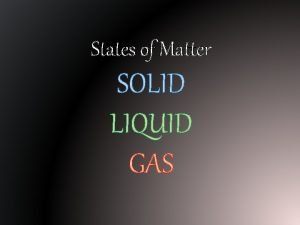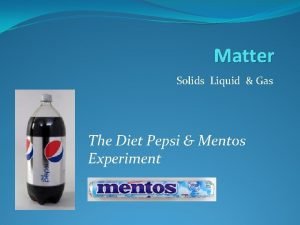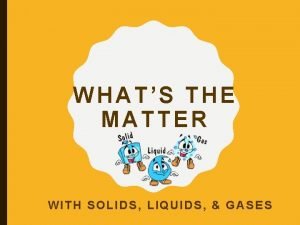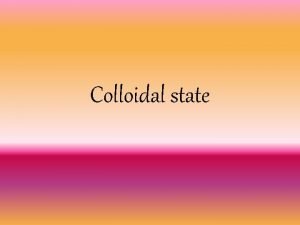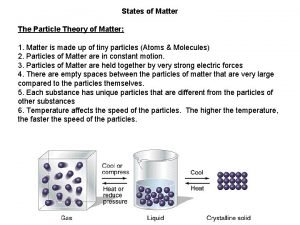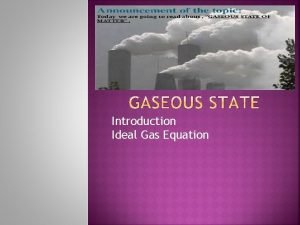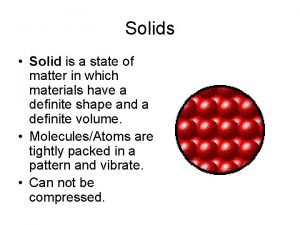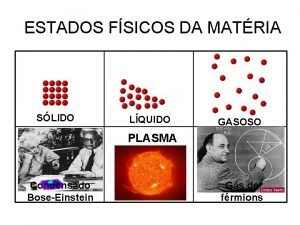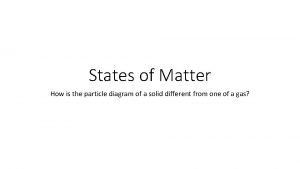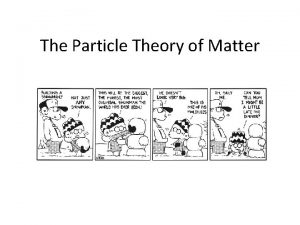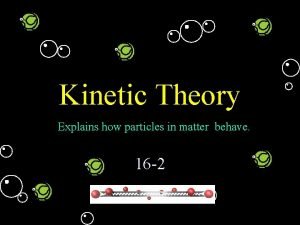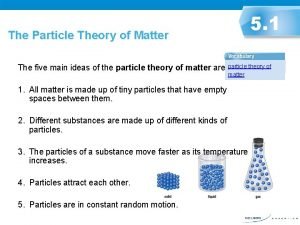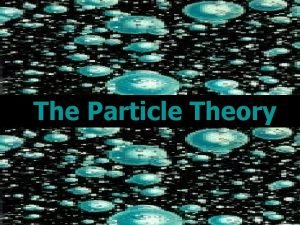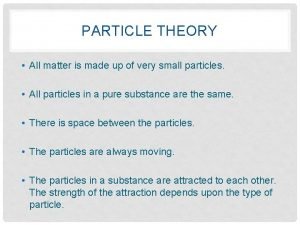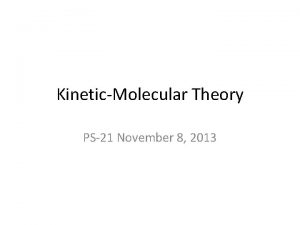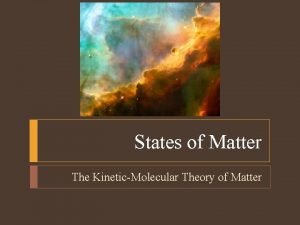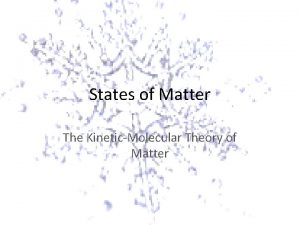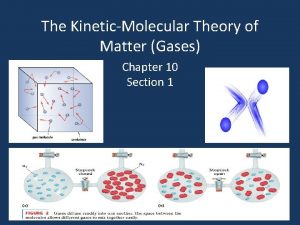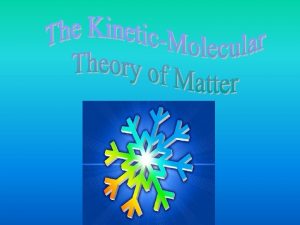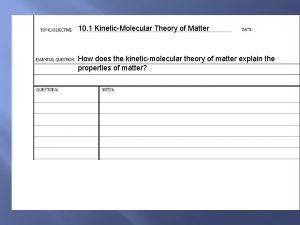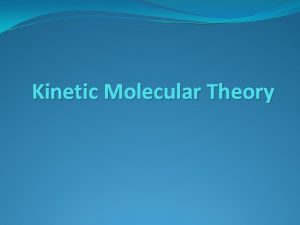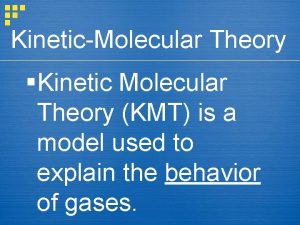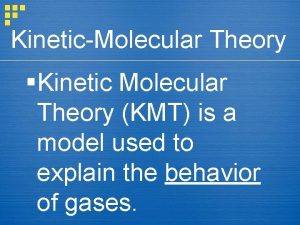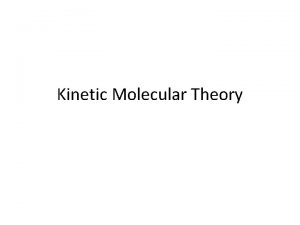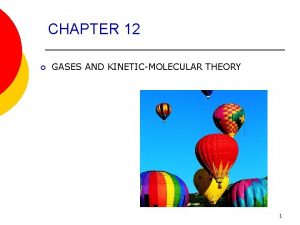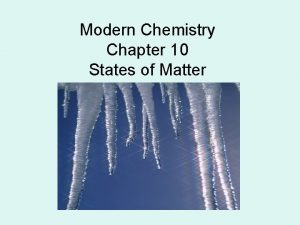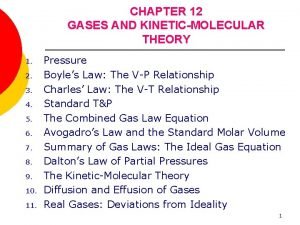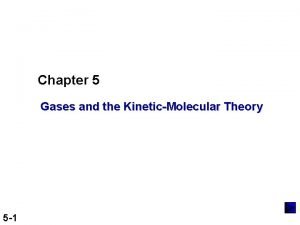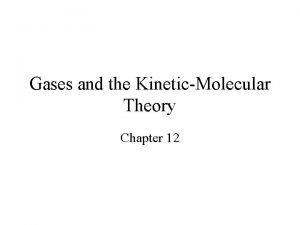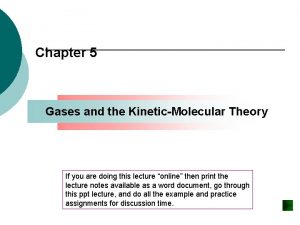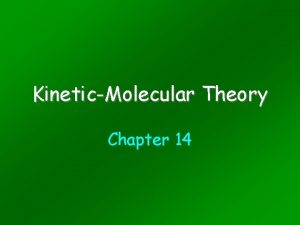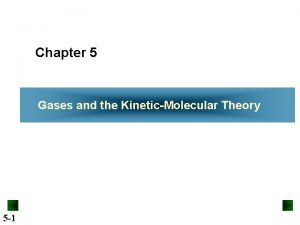State of Matter Chapter 10 KineticMolecular theory The













































































- Slides: 77

State of Matter Chapter 10

Kinetic-Molecular theory • The kinetic-molecular theory is based on the idea that particles of matter are always in motion. • The theory can be used to explain the properties of solids, liquids, and gases in terms of the energy of particles and the forces that act between them.

Kinetic-Molecular Theory of Gases • An ideal gas is a hypothetical gas that perfectly fits all the assumptions of the kinetic-molecular theory. • The kinetic-molecular theory of gases is based on the following five assumptions: 1. Gases consist of large numbers of tiny particles that are far apart relative to their size. • Most of the volume occupied by a gas is empty space • This explains the fact that gases are easily compressed

Kinetic-Molecular Theory of Gases 2. Collisions between gas particles and between particles and container walls are elastic collisions. • An elastic collision is one in which there is no net loss of total kinetic energy. • Kinetic energy is transferred between two particles during collision • Total kinetic energy remains the same as long as temperature is constant 3. Gas particles are in continuous, rapid, random motion. They therefore possess kinetic energy, which is energy of motion.

Kinetic-Molecular Theory of Gases • m is mass v speed

Kinetic-Molecular Theory and Nature of Gases • The kinetic-molecular theory applies only to ideal gases. • In reality Ideal Gases do NOT exist but, mamy gases behave almost ideally • Many gases behave nearly ideally if pressure is not very high and temperature is not very low.

Kinetic-Molecular Theory and Nature of Gases Expansion • Gases do not have a definite shape or a definite volume. • They completely fill any container in which they are enclosed. • Gas particles move rapidly in all directions (assumption 3) without significant attraction between them (assumption 4).

Kinetic-Molecular Theory and Nature of Gases Fluidity • Because the attractive forces between gas particles are insignificant (assumption 4), gas particles glide easily past one another. • Because liquids and gases flow, they are both referred to as fluids.

Kinetic-Molecular Theory and Nature of Gases Low Density • The density of a gaseous substance at atmospheric pressure is about 1/1000 the density of the same substance in the liquid or solid state. • The reason is that the particles are so much farther apart in the gaseous state (assumption 1).

Kinetic-Molecular Theory and Nature of Gases Compressibility • During compression, the gas particles, which are initially very far apart (assumption 1), are crowded closer together. • The volume of a given sample od gas can be greatly decreased

Kinetic-Molecular Theory and Nature of Gases Diffusion and Effusion • Gases spread out and mix with one another, even without being stirred. • The random and continuous motion of the gas molecules (assumption 3) carries them throughout the available space. • Such spontaneous mixing of the particles of two substances caused by their random motion is called diffusion.

Kinetic-Molecular Theory and Nature of Gases • Effusion is a process by which gas particles pass through a tiny opening. • The rates of effusion of different gases are directly proportional to the velocities of their particles. • Molecules of low mass effuse faster than molecules of high mass.

Deviations of Real Gases from Ideal Behavior • Because particles of gases occupy space and exert attractive forces on each other, all real gases deviate to some degree from ideal gas behavior. • A real gas is a gas that does not behave completely according to the assumptions of the kinetic-molecular theory. • At very high pressures and low temperatures, a gas is most likely to behave like a non-ideal gas. • The kinetic-molecular theory is more likely to be true for gases whose particles have little attraction to each other • For example the noble gases

Section 2 Liquid

Properties of Liquids and the Kinetic. Molecular Theory • A liquid can be described as a form of matter that has a definite volume and takes the shape of its container. • The attractive forces between particles in a liquid are more effective than those between particles in a gas. • This attraction between liquid particles is caused by the intermolecular forces: • dipole-dipole forces • London dispersion forces • hydrogen bonding

Properties of Liquids and the Kinetic. Molecular Theory • The particles in a liquid are not bound together in fixed positions. Instead, they move about constantly. • A fluid is a substance that can flow and therefore take the shape of its container.

Properties of Liquids and the Kinetic. Molecular Theory Relatively High Density • At normal atmospheric pressure, most substances are hundreds of times denser in a liquid state than in a gaseous state. • This is due to the close arrangement of liquid particles • Different liquid can differ greatly in density at the same temperature and pressure.

Properties of Liquids and the Kinetic. Molecular Theory Relative Incompressibility • Liquids are much less compressible than gases because liquid particles are more closely packed together.

Properties of Liquids and the Kinetic. Molecular Theory Ability to Diffuse • Any liquid gradually diffuses throughout any other liquid in which it can dissolve. • The constant, random motion of particles causes diffusion in liquids. • Diffusion is much slower in liquids than in gases. • Liquid particles are closer together. • The attractive forces between the particles of a liquid slow their movement. • As the temperature of a liquid is increased, diffusion occurs more rapidly.

Properties of Liquids and the Kinetic. Molecular Theory Surface Tension • A property common to all liquids is surface tension, a force that tends to pull adjacent parts of a liquid’s surface together, thereby decreasing surface area to the smallest possible size. • The higher the force of attraction between the particles of a liquid, the higher the surface tension. • The molecules at the surface of the water can form hydrogen bonds with the other water, but not with the molecules in the air above them.

Properties of Liquids and the Kinetic. Molecular Theory Surface Tension • Capillary action is the attraction of the surface of a liquid to the surface of a solid. • This attraction tends to pull the liquid molecules upward along the surface and against the pull of gravity. • The same process is responsible for the concave liquid surface, called a meniscus, that forms in a test tube or graduated cylinder

Properties of Liquids and the Kinetic. Molecular Theory Evaporation and Boiling • The process by which a liquid or solid changes to a gas is vaporization • Evaporation is the process by which particles escape from the surface of a non-boiling liquid and enter the gas state. • Boiling is the change of a liquid to bubbles of vapor that appear throughout the liquid. • Evaporation occurs because the particles of a liquid have different kinetic energies.

Properties of Liquids and the Kinetic. Molecular Theory Formation of Solids • When a liquid is cooled, the average energy of its particles decreases. • Attractive forces move particles into an even more orderly arrangement • The physical change of a liquid to a solid by removal of energy as heat is called freezing or solidification.

Section 3 Solid

Properties of Solids and the Kinetic-Molecular Theory • The particles of a solid are more closely packed than those of a liquid or gas. • All interparticle attractions exert stronger effects in solids than in the corresponding liquids or gases. • Attractive forces tend to hold the particles of a solid in relatively fixed positions. • Only vibrational movement • Solids are more ordered than liquids and are much more ordered than gases.


Properties of Solids and the Kinetic-Molecular Theory • There are two types of solids: crystalline solids and amorphous solids. • Most solids are crystalline solids—they consist of crystals. • A crystal is a substance in which the particles are arranged in an orderly, geometric, repeating pattern. • An amorphous solid is one in which the particles are arranged randomly. • Plastic and glass

Properties of Solids and the Kinetic-Molecular Theory Definite Shape and Volume • Solids can maintain a definite shape without a container. • Crystalline solids are geometrically regular. • A shard still have district geometric shape • The volume of a solid changes only slightly with a change in temperature or pressure. • Solids have definite volume because their particles are packed closely together. • There is very little empty space into which particles can be compressed

Properties of Solids and the Kinetic-Molecular Theory Definite Melting Point • Melting is the physical change of a solid to a liquid by the addition of energy as heat. • The temperature at which a solid becomes a liquid is its melting point. • At this temperature, the kinetic energies of the particles within the solid overcome the attractive forces holding them together. • The particles can break of from their fix position

Properties of Solids and the Kinetic-Molecular Theory Definite Melting Point • Amorphous solids have no definite melting point. • example: glass and plastics • They have the ability to flow at different temperatures • Amorphous solids are sometimes classified as supercooled liquids, which are substances that retain certain liquid properties even at temperatures at which they appear to be solid. • These properties exist because the particles in amorphous solids are arranged randomly. • Unlike a true liquid these particles are not constantly changing their position

Properties of Solids and the Kinetic-Molecular Theory High Density and Incompressibility • In general, substances are most dense in the solid state. • The higher density results from the fact that the particles of a solid are more closely packed than those of a liquid or a gas. • For practical purposes, solids can be considered incompressible.

Properties of Solids and the Kinetic-Molecular Theory Low Rate of Diffusion • The rate of diffusion is millions of times slower in solids than in liquids

Crystalline Solids • Crystalline solids exist either as single crystals or as groups of crystals fused together. • The total three-dimensional arrangement of particles of a crystal is called a crystal structure. • The arrangement of particles in the crystal can be represented by a coordinate system called a lattice. • The smallest portion of a crystal lattice that shows the threedimensional pattern of the entire lattice is called a unit cell.

Crystalline Solids Binding Forces in Crystals • A crystal and its unit cells can have any one of seven types of symmetry. Binding Forces in Crystals • Crystal structures can also be described in terms of the types of particles in them and the types of chemical bonding between the particles

Crystalline Solids Binding Forces in Crystals • Melting and Boiling Points of Representative Crystalline Solids

Crystalline Solids Ionic crystals—The ionic crystal structure consists of positive and negative ions arranged in a regular pattern. • Generally, ionic crystals form when Group 1 or Group 2 metals combine with Group 16 or Group 17 nonmetals or nonmetallic polyatomic ions. • These crystals are hard and brittle, have high melting points, and are good insulators.

Crystalline Solids Covalent network crystals • Covalent network crystals—In covalent network crystals, each atom is covalently bonded to its nearest neighboring atoms. • The covalent bonding extends throughout a network that includes a very large number of atoms. • The network solids are very hard and brittle, have high melting points and are usually nonconductors or semiconductors. • Include: • Diamond • Quart (Si. O 2) • Silicon Carbide (Si. C

Crystalline Solids Metallic crystals • Metallic crystals—The metallic crystal structure consists of metal cations surrounded by a sea of delocalized valence electrons. • The electrons come from the metal atoms and belong to the crystal as a whole. • The freedom of these delocalized electrons to move throughout the crystal explains the high electric conductivity of metals.

Crystalline Solids Molecular crystals • Molecular crystals—The crystal structure of a covalent molecular substance consists of covalently bonded molecules held together by intermolecular forces. • Covalent molecular crystals have low melting points, are easily vaporized, are relatively soft, and are good insulators.


Crystalline Solids Amorphous Solids • The word amorphous comes from the Greek for “without shape. ” • Unlike the atoms that form crystals, the atoms that make up amorphous solids are not arranged in a regular pattern. • Plastic and glass

Section 4 Changes of State

Possible changes of State


Changes of State and Equilibrium • A phase is any part of a system that has uniform composition and properties. • Condensation is the process by which a gas changes to a liquid. • A gas in contact with its liquid or solid phase is often called a vapor.

Changes of State and Equilibrium • Equilibrium is a dynamic condition in which two opposing changes occur at equal rates in a closed system. • Eventually, in a closed system, the rate of condensation equals the rate of evaporation, and a state of equilibrium is established.

Equilibrium Vapor Pressure of a Liquid • Vapor molecules in equilibrium with a liquid in a closed system exert a pressure proportional to the concentration of molecules in the vapor phase. • The pressure exerted by a vapor in equilibrium with its corresponding liquid at a given temperature is called the equilibrium vapor pressure of the liquid. • The equilibrium vapor pressure increases with increasing temperature. • Increasing the temperature of a liquid increases the average kinetic energy of the liquid’s molecules.


Equilibrium Vapor Pressure of a Liquid • Every liquid has a specific equilibrium vapor pressure at a given temperature. • All liquids have characteristic forces of attraction between their particles. • The stronger the attractive forces, the smaller the percentage of liquid particles that can evaporate into gas phase • Volatile liquids are liquids that evaporate readily. • They have relatively weak forces of attraction between their particles. • example: ether

Equilibrium Vapor Pressure of a Liquid • Nonvolatile liquids do not evaporate readily. • They have relatively strong attractive forces between their particles. • example: molten ionic compounds

Boiling • Boiling is the conversion of a liquid to a vapor within the liquid as well as at its surface. • The boiling point of a liquid is the temperature at which the equilibrium vapor pressure of the liquid equals the atmospheric pressure. • The lower the atmospheric pressure is, the lower the boiling point is.

Boiling • At the boiling point, all of the energy absorbed is used to evaporate the liquid, and the temperature remains constant as long as the pressure does not change. • If the pressure above the liquid being heated is increased, the temperature of the liquid will rise until the vapor pressure equals the new pressure and the liquid boils once again.

Boiling • The normal boiling point of a liquid is the boiling point at normal atmospheric pressure (1 atm, 760 torr, or 101. 3 k. Pa). • The normal boiling point of water is exactly 100°C.


Boiling Energy and Boiling • Energy must be added continuously in order to keep a liquid boiling • The temperature at the boiling point remains constant despite the continuous addition of energy. • The added energy is used to overcome the attractive forces between molecules of the liquid during the liquid-to-gas change and is stored in the vapor as potential energy.


Boiling Molar Enthalpy of Vaporization • The amount of energy as heat that is needed to vaporize one mole of liquid at the liquid’s boiling point at constant pressure is called the liquid’s molar enthalpy of vaporization, ∆Hv. • The magnitude of the molar enthalpy of vaporization is a measure of the attraction between particles of the liquid. • The stronger this attraction is, the higher molar enthalpy of vaporization.

Boiling Molar Enthalpy of Vaporization • Each liquid has a characteristic molar enthalpy of vaporization. • Water has an unusually high molar enthalpy of vaporization due to hydrogen bonding in liquid water

Freezing and Melting • The physical change of a liquid to a solid is called freezing. • Freezing involves a loss of energy in the form of heat by the liquid. Liquid solid + energy • In the case of a pure crystalline substance, this change occurs at constant temperature.

Freezing and Melting • The normal freezing point is the temperature at which the solid and liquid are in equilibrium at 1 atm (760 torr, or 101. 3 k. Pa) pressure. • At the freezing point, particles of the liquid and the solid have the same average kinetic energy. • Energy loss during freezing is loss of potential enegy tha was present in the liquid • Melting, the reverse of freezing, also occurs at constant temperature. solid + energy liquid

Freezing and Melting • At equilibrium, melting and freezing proceed at equal rates. solid + energy ⇄ liquid • At normal atmospheric pressure, the temperature of a system containing ice and liquid water will remain at 0. °C as long as both ice and water are present. • Only after all the ice has melted will the addition of energy increase the temperature of the system.


Freezing and Melting Molar Enthalpy of Fusion • The amount of energy as heat required to melt one mole of solid at the solid’s melting point is the solid’s molar enthalpy of fusion, ∆Hf. • The magnitude of the molar enthalpy of fusion depends on the attraction between the solid particles.

Freezing and Melting Sublimation and Deposition • At sufficiently low temperature and pressure conditions, a liquid cannot exist. • Under such conditions, a solid substance exists in equilibrium with its vapor instead of its liquid. solid + energy ⇄ vapor • The change of state from a solid directly to a gas is known as sublimation. • The reverse process is called deposition, the change of state from a gas directly to a solid.


Phase Diagrams • A phase diagram is a graph of pressure versus temperature that shows the conditions under which the phases of a substance exist. • The triple point of a substance indicates the temperature and pressure conditions at which the solid, liquid, and vapor of the substance can coexist at equilibrium. • The critical point of a substance indicates the critical temperature and critical pressure.

Phase Diagrams • The critical temperature (tc ) is the temperature above which the substance cannot exist in the liquid state. • Above this temperature, water cannot be liquefied, no matter how much pressure is applied. • The critical pressure (Pc ) is the lowest pressure at which the substance can exist as a liquid at the critical temperature.

• The following curves show the temperature and pressure conditions at which two phases can coexist at equilibrium • Curve AB • ice and water vapor • Curve AC • liquid water and water vapor • Curve AD • ice and liquid water

Phase Diagram for CO 2

Section 5 Water

Structure of Water • Water molecules consist of two atoms of hydrogen and one atom of oxygen united by polar-covalent bonds. • The molecules in solid or liquid water are linked by hydrogen bonding. • The number of linked molecules decreases with increasing temperature. • Ice consists of water molecules in the hexagonal arrangement.

Structure of Water • The hydrogen bonds between molecules of liquid water at 0. °C are fewer and more disordered than those between molecules of ice at the same temperature. • Liquid water is denser than ice. • As the temperature approaches the boiling point, groups of liquid water molecules absorb enough energy to break up into separate molecules.

Heating Curve for Water

• Physical Properties of Water • At room temperature, pure liquid water is transparent, odorless, tasteless, and almost colorless. • The molar enthalpy of fusion of ice is relatively large compared with the molar enthalpy of fusion of other solids. • Water expands in volume as it freezes, because its molecules form an open rigid structure. • This lower density explains why ice floats in liquid water.

• Physical Properties of Water, continued • Both the boiling point and the molar enthalpy of vaporization of water are high compared with those of nonpolar substances of comparable molecular mass. • The values are high because of the strong hydrogen bonding that must be overcome for boiling to occur. • Steam (vaporized water) stores a great deal of energy as heat.

• Physical Properties of Water, continued Sample Problem A How much energy is absorbed when 47. 0 g of Ice melts at STP? How much energy is absorbed when this same mass of liquid water boils?

• Physical Properties of Water, continued Sample Problem A Solution Given: mass of H 2 O(s) = 47. 0 g; mass of H 2 O(l) = 47. 0 g; molar enthalpy of fusion of ice = 6. 009 k. J/mol; molar enthalpy of vaporization = 40. 79 k. J/mol Unknown: energy absorbed when ice melts; energy absorbed when liquid water boils Solution: • Convert the mass of water from grams to moles. 2 2 1 mol H O 47. 0 g H O 2. 61 mol H O
 Chapter 2 matter section 1 classifying matter answer key
Chapter 2 matter section 1 classifying matter answer key Section 1 composition of matter
Section 1 composition of matter White matter of brain
White matter of brain Classification of matter section 1 composition of matter
Classification of matter section 1 composition of matter Brain falx
Brain falx Composition of matter section 1
Composition of matter section 1 Gray matter and white matter
Gray matter and white matter White matter vs grey matter
White matter vs grey matter Energy naturally flows from warmer matter to cooler matter
Energy naturally flows from warmer matter to cooler matter State of matter
State of matter 2 properties of a liquid
2 properties of a liquid Which state of matter has the most thermal energy
Which state of matter has the most thermal energy Sixth state of matter
Sixth state of matter Plasma state of matter examples
Plasma state of matter examples Is pepsi solid liquid or gas
Is pepsi solid liquid or gas Physical state of matter
Physical state of matter Changes of state of matter
Changes of state of matter Whats the fourth state of matter
Whats the fourth state of matter Venn diagram solid liquid gas
Venn diagram solid liquid gas Meaning of colloidal suspension
Meaning of colloidal suspension Chemical equation states of matter
Chemical equation states of matter Crystalline substances
Crystalline substances Compressible state of matter
Compressible state of matter State of matter
State of matter Volume solid liquid gas
Volume solid liquid gas 6th state of matter
6th state of matter Liquid particle diagram
Liquid particle diagram Phase change concept map solid liquid gas
Phase change concept map solid liquid gas Hình ảnh bộ gõ cơ thể búng tay
Hình ảnh bộ gõ cơ thể búng tay Bổ thể
Bổ thể Tỉ lệ cơ thể trẻ em
Tỉ lệ cơ thể trẻ em Gấu đi như thế nào
Gấu đi như thế nào Tư thế worm breton
Tư thế worm breton Chúa yêu trần thế
Chúa yêu trần thế Môn thể thao bắt đầu bằng từ đua
Môn thể thao bắt đầu bằng từ đua Thế nào là hệ số cao nhất
Thế nào là hệ số cao nhất Các châu lục và đại dương trên thế giới
Các châu lục và đại dương trên thế giới Công thức tính độ biến thiên đông lượng
Công thức tính độ biến thiên đông lượng Trời xanh đây là của chúng ta thể thơ
Trời xanh đây là của chúng ta thể thơ Cách giải mật thư tọa độ
Cách giải mật thư tọa độ 101012 bằng
101012 bằng Phản ứng thế ankan
Phản ứng thế ankan Các châu lục và đại dương trên thế giới
Các châu lục và đại dương trên thế giới Thể thơ truyền thống
Thể thơ truyền thống Quá trình desamine hóa có thể tạo ra
Quá trình desamine hóa có thể tạo ra Một số thể thơ truyền thống
Một số thể thơ truyền thống Cái miệng bé xinh thế chỉ nói điều hay thôi
Cái miệng bé xinh thế chỉ nói điều hay thôi Vẽ hình chiếu vuông góc của vật thể sau
Vẽ hình chiếu vuông góc của vật thể sau Nguyên nhân của sự mỏi cơ sinh 8
Nguyên nhân của sự mỏi cơ sinh 8 đặc điểm cơ thể của người tối cổ
đặc điểm cơ thể của người tối cổ Thế nào là giọng cùng tên? *
Thế nào là giọng cùng tên? * Vẽ hình chiếu đứng bằng cạnh của vật thể
Vẽ hình chiếu đứng bằng cạnh của vật thể Vẽ hình chiếu vuông góc của vật thể sau
Vẽ hình chiếu vuông góc của vật thể sau Thẻ vin
Thẻ vin đại từ thay thế
đại từ thay thế điện thế nghỉ
điện thế nghỉ Tư thế ngồi viết
Tư thế ngồi viết Diễn thế sinh thái là
Diễn thế sinh thái là Dạng đột biến một nhiễm là
Dạng đột biến một nhiễm là Các số nguyên tố là gì
Các số nguyên tố là gì Tư thế ngồi viết
Tư thế ngồi viết Lời thề hippocrates
Lời thề hippocrates Thiếu nhi thế giới liên hoan
Thiếu nhi thế giới liên hoan ưu thế lai là gì
ưu thế lai là gì Hổ sinh sản vào mùa nào
Hổ sinh sản vào mùa nào Sự nuôi và dạy con của hươu
Sự nuôi và dạy con của hươu Sơ đồ cơ thể người
Sơ đồ cơ thể người Từ ngữ thể hiện lòng nhân hậu
Từ ngữ thể hiện lòng nhân hậu Thế nào là mạng điện lắp đặt kiểu nổi
Thế nào là mạng điện lắp đặt kiểu nổi Particle theory of matter
Particle theory of matter The kinetic theory of matter states that
The kinetic theory of matter states that Kinetic theory of matter definition
Kinetic theory of matter definition Kinetic theory of matter
Kinetic theory of matter The kinetic theory explains how particles in matter behave
The kinetic theory explains how particles in matter behave Define particle theory of matter
Define particle theory of matter Particle theory examples
Particle theory examples Particulate theory of matter
Particulate theory of matter











